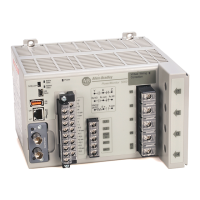Rockwell Automation Publication 1426-UM001J-EN-P - August 2019 503
Glossary
Noise, Electrical Undesired broadband electrical signals superimposed on the power system
voltage.
Notching Periodic voltage distortion created by three-phase power electronic devices when
current is commutated from one phase to another.
Ohm The unit of electrical resistance. One ohm is the value of resistance through
which a potential difference of one volt maintains a current flow of one ampere.
Overvoltage An increase in the rms voltage greater than 110% of nominal for more than 1
minute.
Peak Demand The highest average load over a utility specified time interval during a billing
period. If there is no ratchet clause in the rate schedule, then the peak demand is
also the billing demand.
Phasor Diagram A vector diagram that shows the magnitude and phase relationship of the
voltages and currents in a three-phase system.
Polyphase Having or utilizing several phases. A polyphase power circuit has several
(typically three) phases of alternating current with a fixed phase angle between
phases.
Potential Transformer (PT) A transformer with the primary winding connected in parallel with the circuit
whose voltage is to be measured or controlled. PTs are normally used to step
down high-voltage potentials to lower levels acceptable to measuring
instruments. Also known as voltage transformer (VT).
Potential Transformer Ratio The ratio of primary voltage divided by secondary voltage.
Power Factor The ratio of real power in watts of an alternating current circuit to the apparent
power in volt-amperes. Also expressed as the cosine of the phase angle between
the fundamental voltage that is applied to a load and the current passing through
it.
Power Factor Correction Steps taken to raise the power factor by closely aligning the current to be in phase
with the applied voltage. Most frequently, this process consists of added
capacitance to increase the lagging power factor of inductive circuits.
Power Factor Penalty The charge utilities impose for operating at power factor below some rate
schedule-specified level. This level ranges from a lagging power factor of 0.80 to
unity. There are innumerable ways by which utilities calculate power factor
penalties.
Power Quality Qualitatively, the fitness of electrical voltage to supply power to consuming
devices. Quantitatively, the observed set of electrical characteristics at a given
point on an electrical system as compared to a set of reference conditions.
Rapid Voltage Changes A rapid change is rms value between two steady-state conditions. The magnitude
in the change is less than the sag or swell thresholds.

